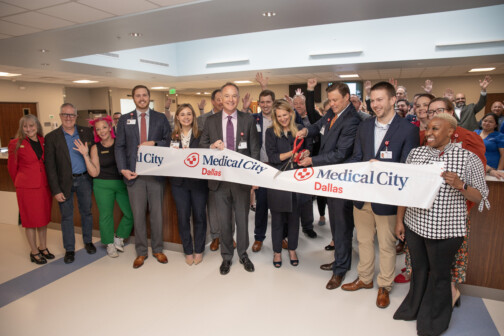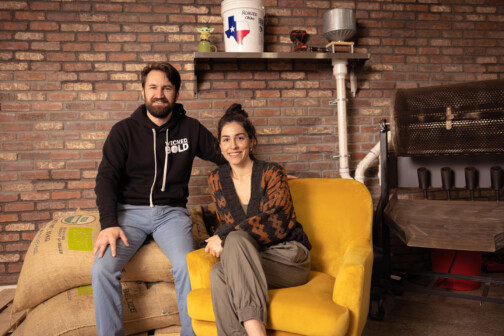A woman sits reading in her quiet Highland Park home. Her husband is outside, doing some repainting around an upstairs window. She tenses suddenly as she hears a crash. She rushes outside to see the ladder toppled and her husband lying bleeding and unconscious on the ground. She panics, first running to his side, then abruptly she realizes she needs help. Racing back to the phone, she opens the directory to the list of emergency numbers on the inside cover. No ambulance service listed. At the top of the page, under “Emergency Ambulance Only,” for all municipalities other than Dallas, she is directed to the “Ambulance Service” section of the Yellow Pages.
Her hands are shaking so badly, she can barely turn the pages, but when she finds this section, she is confronted with 24 ambulance services – none of which is for emergency use, except Richardson Emergency Ambulance Service. Though logic is usually absent in emergencies, the next logical step is “Highland Park, Town of” listed in the white pages. Again, no emergency ambulance service is listed. Finally, she calls information, where she is given the number of the Highland Park Police Department which, in turn, passes the information to the Fire Department, which dispatches an ambulance to her home.
The entire process has taken 5 minutes and 25 seconds.
Chief O.L. Frith of the Highland Park Fire Department maintains that residents are aware that they should dial the Fire Department directly. The Park Cities News and a newsletter circulated with the water bill remind them monthly. But the telephone operator D Magazine talked to hadn’t read these reminders. Nor have nonresidents who have had an accident in the area. And there are people who become disoriented in an emergency and simply forget the number and the town’s emergency jurisdictional divisions.
This confusion is not confined to Highland Park. Only seven cities in Dallas County list their emergency ambulance services separately. Either the fire department or the police handle emergency calls in the other cities, and the operator is frequently unaware of who handles what. In Wilmer the operator not only issued a wrong number for the ambulance service (which belonged to a private funeral home who, in turn, issued another erroneous number) but also gave a number “not in service” for the police.
In Dallas it takes approximately 26 seconds to locate and reach any of the three emergency services if you dial direct and your phone book is near the telephone. To dial the operator, state the department needed, and be connected with that department, takes approximately 43 seconds.
“This time could be further reduced if all emergency numbers are posted near the phone,” says Bill Roberts, Chief of the Dallas Emergency Medical Service (EMS). “And that time could be reduced even more and confusion eliminated if we had a universal number for all emergency services.” But even given the accessibility of an “easy” number, the panic and disorientation that accompany an e-mergency situation consume the largest amount of time and produce the greatest amount of ineffectual communication with the service needed.
“Frequently, when a person does call, he is so upset that he either gives the wrong address or transposes the numbers,” says Dallas Police Officer David Beidelman. “Some don’t even know the city they’re in.” On streets that cross several juris-dictional lines, such as Mockingbird Lane, this is a particularly common problem.
“Most give the first address that pops into their heads,” says Chief Roberts, who has been with the Fire Department for 18 years. “And that address may be where they lived three years ago.
“We had one case where a woman called to report a fire in her house and gave us an address on Lake wood. When the fire-truck arrived, they saw no fire. They returned, listing it as a false alarm. It wasn’t until a pilot landing at Love Field saw flames coming from a residence near the airport, and reported it, that we found the location of the woman who made the initial call.” She had moved to Inwood about a year ago, but in her panic gave her old address.
In another case cited by Dr. James Atkins, the co-director of the paramedic training program and director of the Major and Minor Medicine section of Parkland’s emergency room, a woman witnessed an accident at a church, but gave her home address when calling for an ambulance.
“The ambulance arrived at her home, found no one there and saw no evidence of an emergency. They returned to the station. Twenty minutes later, the same woman called back and was most irate. She again asked for an ambulance to be dispatched – to her home address. Before the dispatchers could verify her location, she hung up. They again went to her home and, presuming she was unconscious or unable to answer the door, broke into the house. Again, they found no one. It wasn’t until another person from the church called, giving the correct address, that an ambulance actually reached the victim.” The church was only two minutes from where the ambulance was stationed; yet it took over an hour for the man to receive treatment.
But the longest lag in an emergency is “from the time the patient witnesses pain and the time he actually calls for help,” says Dr. John Hall, director of the Psychiatry division of Parkland’s emergency room. “Many deny it’s serious until something life-threatening happens.” It is surprisingly common that a person sees someone suffering severe chest pains, but doesn’t call for help until the victim is having trouble breathing or has even gone into cardiac arrest. This is especially significant, since 50% of all heart attack mortalities occur within two hours after the initial chest pains.
The best procedure to follow in an emergency medical situation is to call the ambulance service immediately. The worst thing to do is call your doctor first, as doctors are usually so busy that their response time is slow.
If you see an accident on the road, stop, make sure there are injuries, then call the ambulance. Because of the high rate of nontransportable or non-emergency calls received (49.9%), Dr. Atkins stresses that you should check for injuries before calling. If there are no injuries, call the police. If all three services are needed, call the ambulance first; they can relay the information to the other departments, usually within 20 seconds.
Do not try to make a victim comfortable. If he has suffered a neck injury or has a respiratory problem, a pillow under his head could cause paralysis or choke him. Only if there is imminent danger, such as a fire, should you try to move the victim.
The greatest boon to emergency departments would be education of the public in first aid and Cardio-pulmonary Resuscitation. In Seattle 22 percent of the public has had CPR training after an organized effort by the city. In Dallas only about 2 percent has completed training. All firemen are trained in CPR. The American Heart Association offers free courses, as does the American Red Cross. The Red Cross’ course includes treatment of poisoning and severe bleeding as well.
These two, along with loss of breath control, are the most commonly fatal home accidents, and all are immediately treatable by someone with a basic knowledge of first aid. The Red Cross’ course runs eight hours all year.
Police and fire departments recommend posting emergency numbers near the phone, along with the following instructions of what to give.
1. The reason for your call (fire, shooting,accident, etc.).
2. Your address.
3. The nearest cross street (eases verification of your location).
4. Your telephone number.
But the best thing you can do in anemergency is to remain calm and mentally organized. It can mean the differencebetween a response time of five minutesor one hour – a difference that is unaf-fordable in an emergency.
911: DALLAS NEEDS IT – WHY DON’T WE HAVE IT?
I’o increase response time to indivi-duals in distress and to avoid the inherent confusion that exists in most emergency situations, many cities across the country have adopted a uniform telephone number – 911 – for each of their emergency services – police, fire, and ambulance.
When American Telephone and Telegraph Company devised the system, they envisioned the use of this number in every city in the country, so that whether you were in New York City or Alice, Texas, you could dial 911 for emergency relief. By the end of 1976,600 cities had adopted the system. In Texas, there are about 20. In this area, however, only Carrollton, Coppell, and Irving use it.
Promoters of the system point to increased response time, not only from the emergency departments, but from the public as well. 911 is easy to remember, and resolves the uncertainty of whom to call first when the situation requires multiple emergency services.
Why doesn’t Dallas have 911 yet? In 1967, Scott McDonald, then city manager, proposed a plan which would have included 20 surrounding cities and towns with Dallas. This was necessary at the time, since overlapping exchanges made 911 technically impossible without cooperation from these municipalities.
Negotiations began after several years of discussions with experts at Southwestern Bell. Dallas officials cited all the advantages of a centralized number while the other representatives protested that it would be too costly and that the efficiency of their present systems would suffer from inclusion in a large network.
Poor timing was another factor in the delay. At this same time, Dallas was discussing imposing commuter taxes on suburban residents who worked in Dallas.
Animosity ran high and cooperation low.
The last reason was the delay in finishing Dallas’ new city hall. Plans were to trigger the 911 system in the spring of 1976 when operations would be moved into the new structure. But construction problems delayed the building.
Finally, in December 1976, assistant city manager Jim Favour requested that Bell devise a 911 system for Dallas only, to be implemented by spring of 1978. A selective routing system was developed that will computerize all numbers within Dallas’ jurisdictional boundaries. A person dialing 911 within those boundaries will be connected automatically with central dispatch. Current plans call for the emergency communications center to be moved into the new hall in February, 1978. A central 7-digit number will be set up at that time for police, fire, and ambulance service. This first step of the transition will allow development of the phone staff without the complication of added equipment. Step two – the change to 911 – is now scheduled for the spring of 1979. This change will require determining the volume of calls received by each department, installation of special lines, computerizing Dallas’ 600,000 phone numbers, and possibly installing additional trunk lines.
The system being designed for Dallas will include some special advantages. Pay telephones are being converted to dial tone first, so that an emergency call can be transmitted without coins. Dallas will also have an Automatic Number Identification which will monitor the telephone number and address of the caller on a screen at the dispatch center, making it easier to verify addresses and to find people who have hung up before giving their location.
THE PARAMEDICS: SUCCESSFUL TEAMWORK
It’s 5 o’clock. In an apartment on Royal Lane near North Central Expressway, a 54-year-old man is suffering severe chest pains and shortness of breath. His wife immediately dials the Dallas Emergency Medical Service and within 38 seconds, the dispatcher obtains the information and sends a firetruck and ambulance to the scene. (In cases where heart attack symptoms are present or the victim is unconscious, a firetruck is automatically dispatched along with the ambulance because their response time is greater. They are in three times as many locations as ambulances, and in these situations, additional manpower is usually needed.)
Despite the heavy expressway traffic, the firetruck arrives 31/2 minutes after the call was received. (Average response time is 4 minutes.) Four firemen, one of whom is an Emergency Medical Technician (EMT), enter the apartment.
The man has gone into cardiac arrest.
The EMT takes the man’s pulse as he directs one fireman to start mouth-to-mouth resuscitation, the other to begin massaging the heart. All firemen are trained in Cardio-pulmonary Resuscitation (CPR).
One minute later, the ambulance, which also had to negotiate expressway traffic, arrives. (Average response time: 5 min. 1 sec.)
Two paramedics rush into the apart-ment carrying a three-tiered metal drug box, telemetry equipment which provides direct radio contact with a doctor at Parkland Hospital’s emergency room, and the Amb-Pak, a multi-purpose machine which enables paramedics to administer an electrocardiogram (EKG). The Amb-Pak also contains a defibrillator which employs electro-countershocks to encourage the heart to begin beating.
One paramedic hooks up the EKG while the other calls Parkland’s dispatch center, manned 24 hours a day by a Fire Department EMT. Within 30 seconds, the doctor is on the other end, reading the transmitted EKG and directing the paramedics to defibrillate the patient, start intravenous feeding, administer 2 amps of sodium bicarbonate and 5cc’s of epinephrine and to insert an endotra-cheal tube into the patient’s windpipe so he can breathe without interference from body fluids. The blood pressure is taken. Within two minutes after the paramedics arrived, the man – who upon their arrival would have been considered clinically dead – is conscious.
“It’s like the difference between night and day,” says Dr. James Atkins, director of the Major and Minor Medical Divisions of Parkland’s emergency room. “Because of the initial work by the paramedics, we get many people alive who would not have been salvageable before.”
In 1973, there were 957 people with gunshot wounds that were transported by the EMS; 335 or 35 percent of those people died. In 1974, there were 1276 gunshot wounds, but only 295 died, reducing the mortality rate to 23 percent. The mortality for stab wounds was reduced from 5 percent in 1973 to 1.7 percent in 1974. In addition to the medical achievement, this has lowered Dallas’ homicide statistics.
An EMT or paramedic candidate must complete 14 weeks of recruit school and one year of apprenticeship as a fireman. Following this is 80 hours of classroom training at Southwestern Medical School and 96 hours in clinical practice at a hospital. This level qualifies the candidate as an EMT. Certification as a paramedic entails an additional 150 hours in the classroom, 250 hours in clinical rotation at local hospitals, and 240 hours internship riding with experienced paramedics.
This additional training enables a paramedic to administer drugs, start I.V.’s, and read EKG’s; an EMT cannot administer anything that punctures the skin of the patient nor can he give drugs.
At present, there are 170 certified paramedics and 160 EMT’s. Two paramedics man each of the 23 ambulances, and there is one EMT riding on every fire-truck.
These men are also experts behind the wheel, which accounts for their fast response time when they have to wrestle with 5 o’clock traffic on North Central Expressway and the unpredictability of drivers. A major problem is the refusal of many drivers to pull over and allow an emergency vehicle to pass. Firemen and ambulance drivers are required to have 64 hours of training in handling a vehicle in emergency situations, how to get in and out of small places, to increase their reaction time and to negotiate crowded freeways. They also learn alternate routes to increase their response time.
The training pays off not only in increasing the response time to a person needing help, but in lowering the total number of accidents. The EMS answered 46,371 calls last year and had only 38 accidents.
Get our weekly recap
Brings new meaning to the phrase Sunday Funday. No spam, ever.
Related Articles

News
Medical City Opens ER in Garland and Local Dermatologist Named Youngest Ever President of the American Academy of Dermatology
Plus Health Wildcatters wins accelerator competition and DFW Hospital Council Foundation awards.
By Bridget Reis

Business
Wicked Bold Chocolate CEO and Comedian Deric Cahill on Why it Pays to Be Funny
The brand leans into humor, but the business' success is no laughing matter, with products in nearly 2,000 retail locations nationwide.
By Will Maddox

D CEO Award Programs
Nominations Open: D CEO’s 2024 Corporate Counsel Awards
The annual program honors top in-house attorneys in Dallas-Fort Worth, from outstanding up-and-comer to outstanding general counsel.


